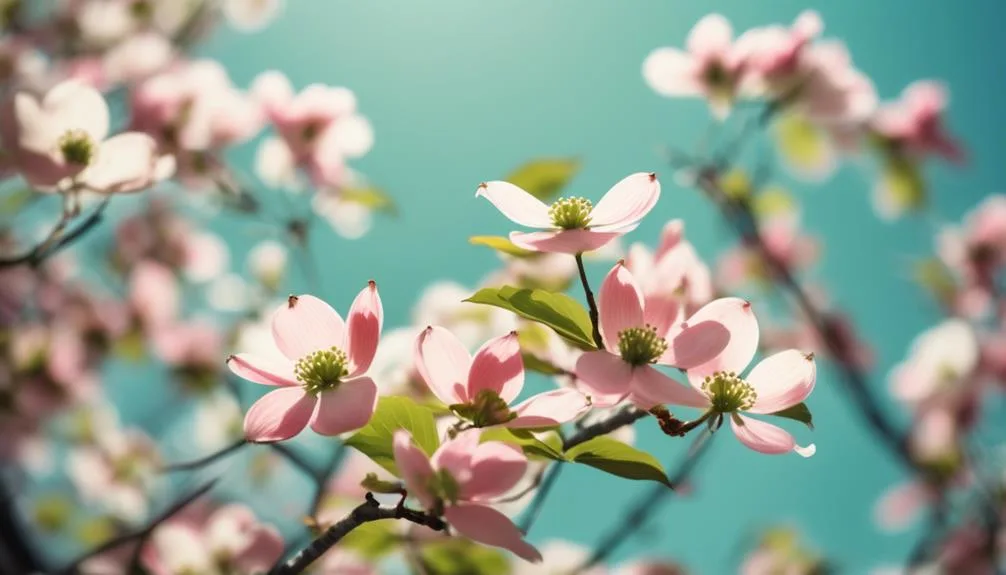Dogwood trees bloom in spring, creating a beautiful sight. Ever wondered what causes this?
Temperature, light, and hormonal changes play a role. Understanding the reasons behind this annual display reveals the mechanisms driving the tree's captivating blossoming.
Temperature and Light Influence
To ensure healthy blossoming, dogwood trees require the right balance of temperature and light. Seasonal cues play a crucial role in the growth response of these trees.
As the days lengthen and temperatures rise in spring, dogwood trees receive the signal to start their growth cycle. The increase in temperature and the longer daylight hours stimulate the production of hormones that trigger the formation of flower buds.
Adequate sunlight is essential for the process of photosynthesis, which provides the energy needed for the tree's overall growth and the development of vibrant blossoms.
Without the right balance of temperature and light, the growth response of dogwood trees may be delayed or stunted, affecting the timing and quality of their blossoming.
Hormonal Changes in the Tree
As the temperature and light conditions prompt the production of hormones in dogwood trees, their hormonal changes are essential for initiating the formation of flower buds and the subsequent blossoming process. Growth hormones play a pivotal role in regulating the seasonal cycles of the tree's development. These hormones, such as auxins and cytokinins, are responsible for stimulating cell division, elongation, and differentiation, all of which are crucial for the growth of flower buds. Additionally, the regulation of hormones like gibberellins and abscisic acid influences the timing and coordination of flowering. These hormonal changes are intricately linked to the tree's response to environmental cues, ensuring that the blossoming process aligns with optimal conditions for pollination and seed development.
| Growth Hormones | Regulation |
|---|---|
| Auxins | Stimulate cell division and elongation |
| Cytokinins | Promote cell differentiation |
| Gibberellins | Influence timing of flowering |
| Abscisic Acid | Coordination of flowering with environmental cues |
Adaptation to Spring Conditions
Amidst the changing landscape of spring, dogwood trees dynamically adjust their biological processes to thrive in the shifting environmental conditions. To adapt to seasonal growth, dogwood trees undergo a series of remarkable changes, ensuring their survival and reproduction:
- Blossoming Timing: Dogwood trees carefully time their blossoming to coincide with the availability of pollinators, maximizing their chances of successful reproduction.
- Water Regulation: As weather patterns fluctuate, dogwood trees adeptly regulate their water uptake and loss, preventing dehydration during dry spells and avoiding waterlogging during heavy rains.
- Nutrient Allocation: With the onset of spring, dogwood trees efficiently allocate nutrients to support vigorous growth and the development of flowers, ensuring the continuation of their species.
In this way, dogwood trees exemplify the incredible adaptability of nature in response to the ever-changing conditions of spring.
Pollination and Reproduction
Dogwood trees' remarkable adaptability in timing their blossoming to coincide with the availability of pollinators directly impacts their successful reproduction, highlighting the intricate relationship between pollination and the continuation of their species.
Cross-pollination benefits dogwood trees by increasing genetic diversity, which can result in stronger and more resilient offspring.
The reproductive cycle of dogwood trees begins with the emergence of their blossoms, attracting various pollinators such as bees, butterflies, and birds. These pollinators facilitate the transfer of pollen between individual trees, leading to fertilization and seed production.
The seeds produced from this process are then dispersed, contributing to the propagation and survival of the species.
This complex interplay between timing, pollinators, and reproduction underscores the evolutionary strategies that dogwood trees have developed to ensure their continued existence.
Environmental Triggers for Blooming
Attracting pollinators through a combination of environmental cues and internal signals, dogwood trees time their blooming to maximize the chances of successful reproduction. The blooming of dogwood trees is triggered by a variety of environmental cues and genetic factors, ensuring that the timing aligns with optimal conditions for pollination and flower development.
Here are some key environmental triggers for blooming:
- Seasonal Cues: Dogwood trees rely on changes in temperature and daylight to gauge the arrival of spring, signaling that it's time to bloom.
- Flower Development: Environmental factors such as moisture, light, and temperature play a crucial role in stimulating the growth and development of dogwood flowers.
- Genetic Factors: The tree's genetic makeup also influences its flowering time, dictating when it will bloom in response to the environmental cues.
Conclusion
In the end, dogwood trees' blossoming in spring is a harmonious interplay of nature's elements. It ensures their survival and gifts us with a yearly spectacle of natural beauty.
What other unseen marvels of nature await our discovery?

My interest in trees started when I first saw the giant sequoias in Yosemite.
I was a teenager then, and I remember thinking, “I need to learn more about this.”
That moment stuck with me.
A few years later, I went on to study forestry at Michigan Tech.
Since graduating, I’ve worked in a mix of hands-on tree care and community education.
I’ve spent over ten years helping people understand how to plant, maintain, and protect the trees in their neighborhoods.
I don’t see trees as just part of the landscape.
They are living things that make a real difference in our daily lives.
